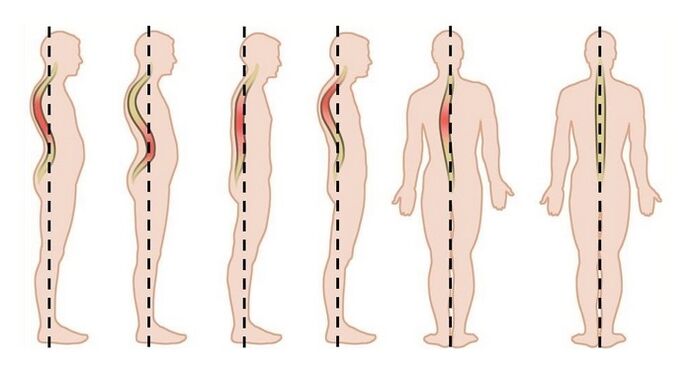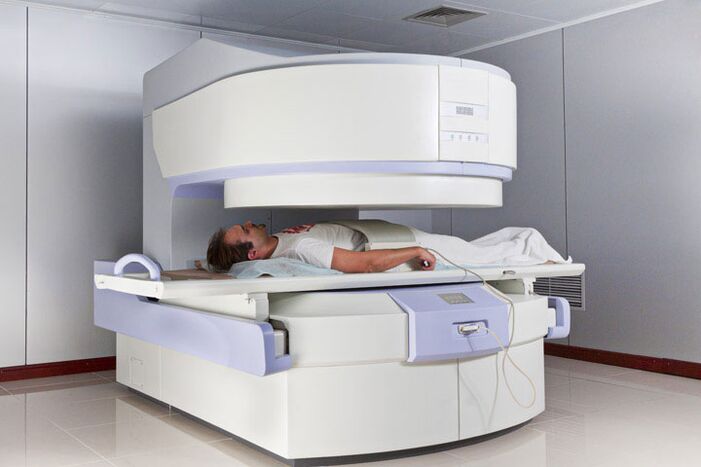
Osteochondrosis is one of the most frequently diagnosed spinal pathologies. This pathology has a degenerative-dystrophic nature of origin, affecting the intervertebral discs, leading to their structural and external modifications. Doctors define three types of disease: cervical, thoracic and lumbar osteochondrosis, depending on the location of the disorder in the spinal space. If we talk about the identified pathological statistics, it is believed that thoracic osteochondrosis is less common than other types. This is due to the peculiarity of the structure of the human spine in the thoracic region: these posterior intervertebral discs have limited mobility, which significantly reduces the likelihood of their traumatic injury.
Is thoracic osteochondrosis
Identifying the disease is difficult, because its symptoms are often similar to pathological changes in other organs: heart, stomach, and so on. Thoracic osteochondrosis is dangerous in its consequences, therefore early detection provides more opportunities for timely correction and prevention of unwanted consequences. The same disease is often diagnosed in patients of both sexes of different ages, including children. Let's discuss in more detail about the causes of osteochondrosis of the chest, its symptoms, methods of treatment with medications and at home.
Osteochondrosis of the thoracic spine manifests itself as a degenerative-dystrophic disorder in the bone structure, the cartilage tissue of the vertebrae, which provokes the development of destructive processes in it. In addition to the vertebrae themselves, the intervertebral discs suffer: they are stratified, reducing in size, because the nerve endings in the intercostal space are pinched. All of these together affect the normal function of the spine. Treatment begins at the wrong time exacerbates the condition, which is then resolved exclusively with the help of surgical operations, which are not always able to be resolved by the patient for a variety of reasons.
Chest osteochondrosis can trigger the development of relatively serious and dangerous diseases and conditions. It is often the cause of pneumosclerosis, narrowed blood vessels, dysfunction of the genitourinary system, cancer pathology, and others. If osteochondrosis progresses rapidly, this usually limits a person’s physical ability: it is difficult for him to walk, work, and do his job freely. regular activity.
With the development of osteochondrosis in patients, vertebral bone components are initially affected, then cartilage, and, finally, connective tissue and adjacent muscles.
If the signs of osteochondrosis appear in childhood or adolescence, adolescence, then this is a dangerous situation, because it indicates that a person's musculoskeletal system begins to age without being formed and fully developed. Osteochondrosis of the thoracic spine in children is rarely diagnosed. But the diseases detected often indicate that there are some other dangerous diseases.
Similar pathologies are often found in men and women. No age -specific preferences either. But it should be noted that women are more often susceptible to this disease during the period of hormonal changes in the body - menopause.
If you start the treatment of thoracic spine osteochondrosis at an early stage, then there is a better chance that the therapy will give a positive result.
Disease stage and characteristic symptoms
The development of osteochondrosis of the thoracic spine is gradual, several different stages. For the proper organization of the treatment process, it is necessary to understand the mechanisms of its development and progression.
- The early stages of the degenerative-dystrophic process occurring in the spinal column are characterized by a slight decrease in the size of the intervertebral disc. Small cracks begin to appear on the surface of the fibrous annulus of the intervertebral disc. The disc may protrude slightly from the vertebral column. At the same time, first -degree thoracic osteochondrosis does not reveal itself as a painful sensation, often a person is unaware of the newly emerging dangerous disease. With the help of computed tomography, disc protrusion (slight loss) is detected.
- If a person has grade 2 thoracic osteochondrosis, then painful manifestations in the back in the chest area begin to appear. This is explained by the fact that the nerve fibers are pinched. The musculo-ligamentous apparatus of the back, i. e. muscular corset, providing optimal support of the spine in the correct anatomical shape. To avoid spinal instability, it is very important to shape the back muscle structure symmetrically. Otherwise, there is not only a violation of posture, curvature of the spinal column, but also excessive mobility of its individual elements. It is due to increased mobility of the vertebrae that the nerve fibers that leave the spine through the intervertebral space are pinched. How is osteochondrosis manifested in the second stage? Back pain in the second stage of thoracic osteochondrosis inevitably appears. It has different characteristics: it can be interesting for a long time or short term, in the form of seizures. This condition is exacerbated by the fact that the nerve endings are compressed directly inside the muscle, which is regularly in increasing tone.
- The morphological signs of third-degree thoracic osteochondrosis are very pronounced, it affects all anatomical components of the spinal structure. The patient has the following pathological picture: there is a hernia and protrusion of the intervertebral disc, muscles and ligaments become inflamed, tears appear on them, the vertebrae are moved, signs of arthrosis of the vertebral joints develop. The clinical picture of spinal disease in the third stage is very diverse. In addition to the fact that a person actually experiences pain in chest osteochondrosis, the patient loses the tactile reaction of the part of the body where the damaged nerve passes; he has a disorder of the autonomic nervous system, which is accompanied by damage to the respiratory and circulatory systems. It becomes difficult for him to breathe, there is pain in the heart, arrhythmias, shortness of breath. In addition, patients experience arthrosis of several joints at once, and pathological disorders begin in the function of organs located in the chest area. The same symptoms appear when the intervertebral fissure decreases by two -thirds of its height. Its size is assessed by a chest x-ray, which is done in two projections: straight and lateral.
- With the development of degenerative processes in the spine to fourth degree osteochondrosis, the intervertebral cleft narrows to a minimum, dangerous conditions such as spondylosis, spondyloarthrosis (characterized by pathological changes in the intervertebral joints), spondylolisthesis (twisted or dislocated vertebrae) develop. The body mobilizes its compensatory ability to reduce static and dynamic loads on the spinal column, to prevent injury to anatomical elements, which causes the vertebrae to grow, flatten, and grow together with each other. The area of the damaged fibrosus annulus is replaced by bone structure, osteophytes (bone plants) are formed, due to prolapse of the vertebral disc, the spinal cord narrows, nerve endings are strongly compressed, thoracic motor activity. the spine is significantly limited, the person is constantly in pain in the chest area from behind.
- As a result of the development of the disease, the patient experiences lumbago pain in the lower back (lumbago), the legs are completely or partially paralyzed, the person loses the ability to work, becomes disabled.
The various manifestations of disease symptoms depend on various causes, including a person’s genetic predisposition. The same symptoms of thoracic spine osteochondrosis fail in different patients in different ways. There is an objective explanation for this: various causes, circumstances of occurrence and general conditions of human health lead to osteochondrosis. Symptoms of thoracic osteochondrosis in men appear somewhat earlier than in women. The main reason for this phenomenon lies in the physiological structure of the female body: the hormone estrogen protects the intervertebral disc, therefore, especially favorable conditions for the disease arise during changes in the hormonal background (during pregnancy, menopause).
Many are interested in whether they were taken with osteochondrosis into the military. If a soldier has first -degree osteochondrosis, he or she will be drafted into the army. In the case when a young man has a clear symptomatology of the disease, it is observed by a neuropathologist, then the delay is possible, in a neglected condition (if there is polysegmental osteochondrosis of the thoracic spine), they may not call at all.
Because of the appearance
Thoracic osteochondrosis at the beginning of its occurrence is practically not shown in anything. However, you need to know why it might appear. The following causes trigger pathology:
- Frequent excessive static or dynamic stress on the spine is caused by active strength training in professional athletes or people engaged in sports without the necessary load control.
- Traumatic damage to the bones, articular elements of the spine often leads to the fact that they are not united properly, quickly collapse. Any injury to the spine is exacerbated by pathological changes in the structural function of the nervous and circulatory systems. The supply of necessary nutrients to the bones is often restored over a very long period of time.
- Poor posture, congenital or acquired curvature of the spinal space, leading to an unbalanced effect on the intervertebral disc.
- Lifting weights abruptly, when part of the heavy load falls on the back chest. If a person constantly performs such movements, then the likelihood of developing chest osteochondrosis is high.
- Disorders in the endocrine system. In the case when metabolic processes are disrupted in the body, all other organs and tissues do not receive the necessary nutrients, and their regeneration is also improper.
- Genetic prerequisites for possible pathological processes in the vertebrae, intervertebral discs. In this case, thoracic osteochondrosis manifests itself in any age category.
- Inadequate physical and physical activity of a person, sedentary work. The skeletal muscle of the back in this condition is weak, tissue nutrition is declining, spinal flexibility is reduced, and the risk of developing thoracic osteochondrosis is significantly increased.
- Lack of development of all tissues of the musculoskeletal system, which leads to degenerative disorders of the spine. The cause is an unbalanced and excessive load on the spine.
- Various pathological changes in the intervertebral disc. They can become thinner or, conversely, grow, osteophytes can appear on them, disrupting joint function, as well as damaging blood vessels and imposing compression on nerve fibers. The development of an intervertebral hernia often leads to the development of osteochondrosis.
- Inflammatory processes in the spine or nearby muscles often cause signs of thoracic osteochondrosis in women and men.
- The blood supply to the spinal cord is affected, due to the fact that the veins and arteries narrow or constrict.
- The consequence of an infectious disease is the development or worsening of osteochondrosis.
- Hypothermia, abuse of bad habits, nutritional imbalance.
- Separately, psychosomatic is differentiated, that is, constant stress, nervous excitement can also cause osteochondrosis.

There are several reasons for the development of thoracic osteochondrosis, therefore, to prevent its development, you need to pay attention to prevention.
Common Symptoms
The symptoms of breast osteochondrosis in women and men are similar. Typically, progressive disease during exacerbation is indicated by the following symptoms.
- Strong pain in the thoracic spine. They arise from long stays in uncomfortable positions during physical labor.
- Radicular syndrome, due to compression of nerve endings.
- Intercostal neuralgia.
- The appearance of cramps in the back muscles.
- The condition of the heart muscle is altered, in which the pain does not disappear by taking special medications.
In addition, during an attack of thoracic osteochondrosis, patients may experience atypical symptoms: tachycardia, dizziness, heartburn, increased or decreased blood pressure. Body temperature, as a rule, does not change.
Diagnostic techniques
If the doctor considers that the patient has osteochondrosis, then he or she will recommend to undergo the following studies to diagnose the pathology.
- X-ray examination, in which they determine: the boundaries and size of the intervertebral disc, existing bone growth, changes in the shape of the vertebrae, etc.
- Radiography with a contrast agent allows you to assess the degree of disc destruction in the diagnosis of osteochondrosis of the thoracic region.
- CT or MRI shows a layer -by -layer display of altered structures. This technique is used in the most difficult situations.
- With the help of electromyography, neurological signs associated with disease in the thoracic region are differentiated.

The main rules of treatment
When treating osteochondrosis of the thoracic region, the following main points are observed:
- With the early manifestation of signs of osteochondrosis, you can prevent further development by correcting your posture.
- Any, even minor, symptoms of the disease require conservative therapy.
- To achieve positive results in treatment, long -term and systemic use of additional techniques for drug therapy is required.
- If the disease is ignored, then surgery is required.
When deciding how to treat osteochondrosis in the thoracic region, the doctor will take into account the stage of development of the disease, the individual characteristics of the patient, as well as the possibility of side effects of the body.
Drug treatment
Conservative therapy involves the use of the following groups of drugs.
- To reduce the manifestations of pain and inflammation, nonsteroidal anti-inflammatory drugs, painkillers, or glucocorticosteroids are prescribed. They are available in different pharmacological forms (tablets, solutions for injection, ointments), therefore, what exactly to treat the disease, the doctor will advise.
- Chondroprotectors are used to stimulate cartilage tissue recovery.
- To relieve muscle spasms, antispasmodics and muscle relaxants are used.
- To relieve unbearable back pain, patients may be offered to give injections for osteochondrosis - to carry out the blockade with the help of anesthetic drugs.
As a combined treatment for thoracic osteochondrosis, it is possible that the following additional treatment methods are widely used.
- With the help of acupuncture, you can quickly get results - pain relief. The advantages of the technique include: high efficiency in a short time, the occurrence of rare side effects of the body, a list of insignificant contraindications, painless technique. Acupuncture is not practiced if a person is diagnosed with the presence of malignant neoplasms, there are mental disorders, during the exacerbation of inflammation and pregnancy. The duration of treatment is chosen individually.
- Through the possibility of manual therapy, the blood supply to the damaged areas of the body is improved, the intensity of pain is reduced, muscle spasms are eliminated, ligaments are restored, the development of osteochondrosis slows down.
- Treatment of osteochondrosis with the help of physiotherapy is practiced everywhere, because, using it, drugs are injected into the sore spot. This is how, for example, electrophoresis with NSAIDs, glucocorticosteroids, etc. is used. In addition to electrophoresis, UHF, magnetotherapy, and vacuum are often prescribed. The main goal, achieved with physiotherapy techniques, is to improve blood circulation in the painful area.
- To relieve cramps in the back muscles, a course of massage is often prescribed. Classical massage is used during remission, and vibration massage - in the acute period. If the patient has an intervertebral hernia, then it is not recommended to use massage techniques.
- Physical therapy is very important in treatment. The specific training set in each case is selected by the doctor individually.
- During the treatment of osteochondrosis, diet is important. In the diet of patients, it is important to include protein in the required amount, chondroitin (for this you need to eat jelly, jelly meat, aspic dishes), vegetables, fruits. You must not overeat; excluding the consumption of fried and fatty foods.
How to treat chest osteochondrosis at home
Treatment with folk remedies can also be practiced, but before using any of them, you should consult with your doctor. The following recipes are popular.
- To prepare the infusion of celery root, take 3–4 g of raw material, grind, pour 1 liter of boiling water. After 8 hours, strain the infusion, drink up to three times a day with a dessert spoon.
- To prepare the soup, take 2-3 sunflower roots, cut about 1 cm, pour three liters of boiling water and boil for another 3 minutes. The medicine is used like tea.
- At home, you can prepare an ointment for rubbing the sore spot. 150g of lard mixed with 2 tbsp. l. wax, heated for 20 minutes in a water bath, then add 1 tbsp. l. fir oil, continue to heat the same amount, then add 1 tbsp. l. ammonia. Products are stored in glass containers in a cool place.
Treatment of chest osteochondrosis at home is usually used in a mild period or in addition to medications during exacerbations.
Osteochondrosis of the thoracic spine is a disease that must be taken seriously to avoid negative consequences. For a successful treatment, you should carefully consider the doctor’s advice and follow it in a disciplined manner.

























